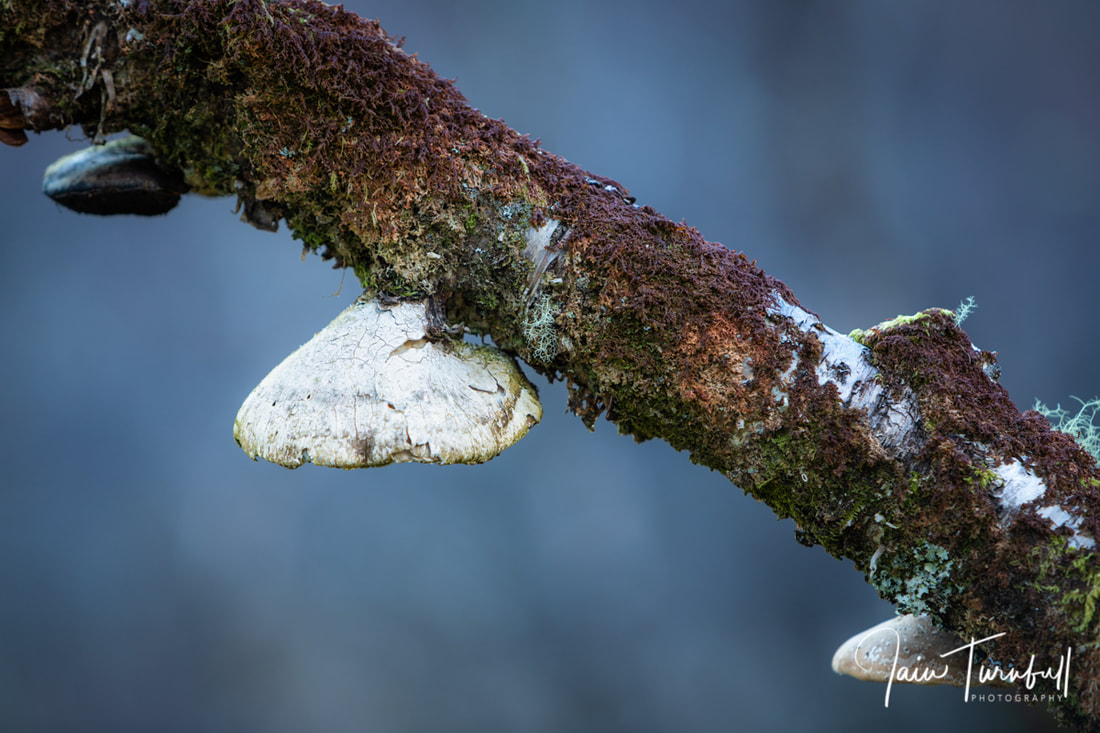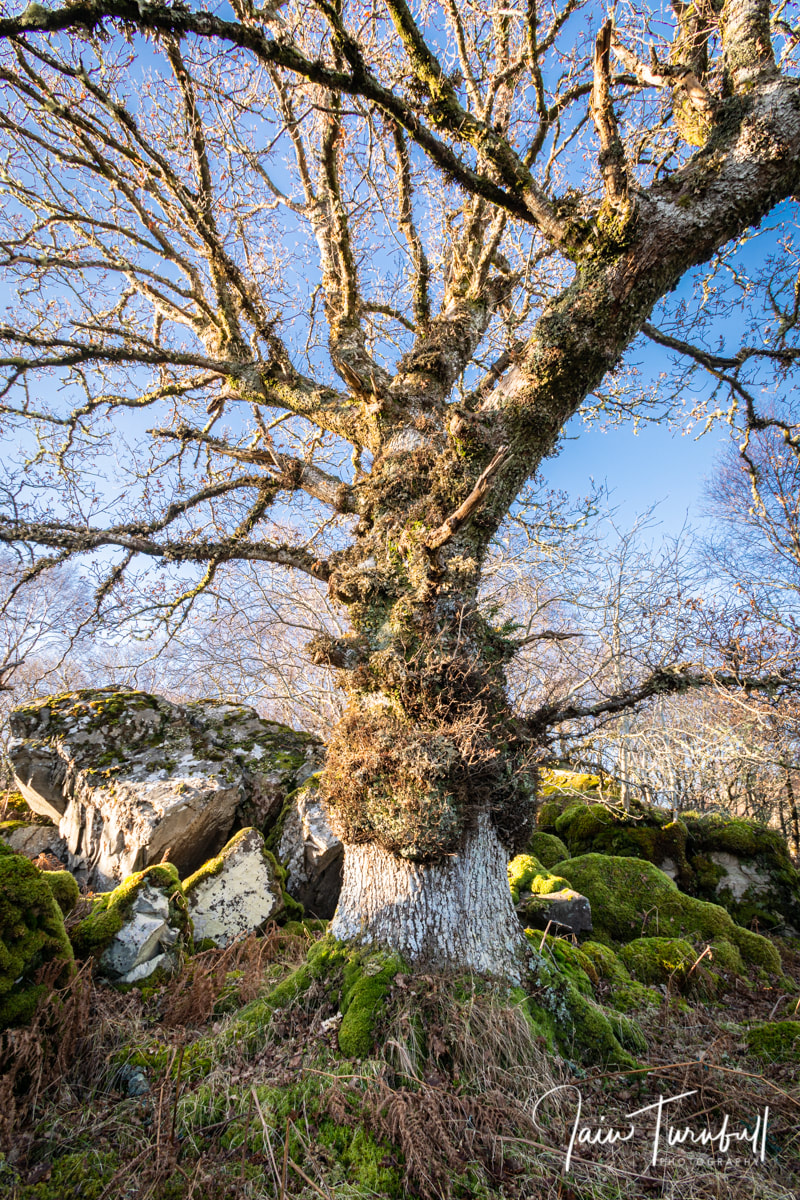|
After a lovely day with too many small things happening to allow time for a proper outing with the camera I managed a quick trip with my wife along to Kintail just in time for the developing blue hour. The snow on the hills was making them glow beautifully against an increasingly dark blue sky. I chose one of my favourite locations near Ratagan, overlookig Loch Duich with the Five Sisters of Kintail and Ben Attow as a backdrop. Using a combination of two of my ND Grad filters to balance the exposure, and my ultra-wide-angle lens (17-35mm), I set up in various places to try and get the old seaweed covered shore fence and the salmon trap in the foreground. In processing, I selectively adjusted the colour balance a bit to bring out the colours in the foreground, a bit more like it actually was, and the above shot is the result. I also tried converting this one to black & white using Silver Efex Pro II (see below) On the way home the sun had pretty much set in the west but there was a faint glow behind the Cuillins on Skye and Eilean Donan Castle was all lit up for the night as usual. I made a snap decision to pull into the deserted car park and shot these two images.
0 Comments
I decided today was a day for a return to the woods of the Balmacara estate, specifically the oak-birch woods above Duirinish. I wanted to look close-up at some of the lichens and fungi growing on the trees as well as some of the amazing textures on the bark of the older trees. This first image is of three different types of bracket fungus growing on a birch branch. The branch is also covered in an array of lichens and bryophytes, almost completely smothering the bark. The subtle colours are wonderful, offset against the blue/purple backdrop of the winter birchwood. I shot the next image very close to the first, on a different tree at a more oblique angle. I took several shots at different apertures to try and get a sense of the depth of field in the shot, with soft foreground and background, while still retaining a fully sharp focal point on the fungus. I think the first of the two (shot at f/16) is the better but the very shallow deth of field in the second (shot at f/4.0) has a certain appeal. The tones and textures in these woods are fantastic and no matter how often you return you always see something new and wonderful. This old oak tree has a wonderfully striated stem, with a huge burr and a wide array of lichens, bryophytes and mosses. I took a selection of this tree from a wide angle right down to a close-up of the stem. Just to the far sde of this old tree is an amazing group of large boulders, all covered completely in green moss. You can just see them in the background of the above shot, but from in front they are truly impressive, especially when they are set off against a clear blue sky as was the case today. The next group of three images is of a white lichen (I think) but I do not know its name. I will check this out with a friend who is pretty good at lichens and I'll update this post once I find out what it is. Suffice to say I have never seen this one before. It is a rather lovely and delicate structure, somewhat like small white trees. I shot a wide angle of it in its location on the tree stem, a closer view and a very close macro shot of the strucutral detail. It was very hard to get a good focus on the detail as the depth of field was incredibly shallow, but I think it should be good enough to get an ID. Finally, after finishing in the woods I headed home via Duirinish and Broadford, not specifically to take photos, but I ended up stopping at the Gorstan at Drumbuie and took this panoramic shot across the croft lands to the snow covered Applecross and Torridon hills. A magnificent view on a day like today.
It was a truly beautiful day today, and with the snow from yesterday the landscape was looking wonderful. I could not resist going for a walk round the coast between Duirinish Station and Port an Eorna, through the crofts at Drumbuie and Duirinish and along the coast overlooking Skye and the Applecross Hills. I took my usual camera backpack but also my Holga 120N medium format plastic camera loaded with out-of-date Kodak Tri-X black & white film. I have not used this camera for the best part of a year and wanted to experience the freedon of having only a very few options in terms of camera settings: one shutterspeed or bulb setting; two apertures - bright sun or cloudy; and four focus settings - portrait, group portrait, middle distance; and landscape. It does take a lot of practice to get right, and the images are soft due to the plastic lens and usually heavily vignetted, producing an amazing atmospheric style, made famous by Michael Kenna. Of course you need to wait until the film is complete and then develop it, etc. I now have three shots left on that roll of film, so will try and complete it soon and post up the results (good or bad) once I have it developed. Anyway, I took a few shots with my digital camera. The above image is a reprise of one I made for my Higher Photography course back about five years ago. That project was a study of the crofting cultural landscape and I was trying to capture the human imprint on the landscape through things like fence lines, settlement patterns, cropping, etc. This new version was taken on a much more favourable day, with some blue sky and intertesting clouds as well as sunlight and shade. The snow brings out the textures in the landscape and I like the way the fence on the right and the tracks in the snow lead the viewer's eye into the frame. I love the texture in the old fence post in the foreground right. When I shot this view previously I had taken a creative decision to make all my images black & white for the project, partly because I was shooting in the depths of winter with limited colour, but also because I really like that style. So, I decided, despite today's image working well in colour, to convert it to monochrome by way of a comparison with the one taken five years ago (see below). Below is the version I produced back in early 2016 (below left) with a more recently re-processed version of the same RAW file (below right). I like the softness of the original although it does look relatively flat, lacking contrast and punch. I guess some folk would prefer that style of image and I do like the soft tones in the sky. The more recent version reflects my journey in post-processing and I think makes for a better finished product. Today's image was processed in Lightroom using what I have learned over the past few years to create more dramatic and punchy images. In recent times I have often resorted to using Silver Efex Pro for my B&W conversions (see below right) and I still like some of the options that are provided in that software. However, I am trying to simplify my workflow and reduce the amount of processing to produce a more natural product and so decided to stick to Lightroom, apart from the border which was created in Photoshop. Further round the coast I stopped for a while by the shore, looking out towards Skye and Raasay. This view is always changing, depending on the time of day, time of year and the prevailing weather. Today, despite being cold with a slight breeze, it was relatively benign for the winter, with sunshine, blue sky and thin wispy clouds as a backdrop for the snow covered Cuillins of Skye. This image did nothing for me in colour and I had intended to convert it to B&W when I took it anyway, so the image below is the result of processing in Lightroom with the border created in Photoshop. The 3 stop grad filter helped to balance the strong contrast between the dark rocks in the foreground and the much brighter sky, especially just above the hills of Skye. I also applied a digital grad filter in Lightroom increasing the clarity in the sky to bring out the clouds a bit more, and another in the foreground to further brighten the rocks without over-exposing the middle ground and sky. Otherwise, I opted for the Adobe Black & White conversion with Yellow Filter in the profiles menu, and this resulted in a darker sky (turning blue into darker black). Compositionally, it is not the best in my opinion, but the clouds provide a sense of incredible depth and distance, from the relatively low vantage point, making for a reasonably compelling image. Looking back, I might have shifted my location to the right and tried to create more by way of leading lines along the coast. However, that may have resulted in too much brightness from the sun which is off to the left in this shot.
The last couple of days have produced some snowy weather and as always the hills look fantastic when dusted with the white stuff. Yesterday I had the pleasure of a work trip over to Strome Castle at North Strome (near Lochcarron). Afterwards I quickly nipped over the hill towards Kishorn to see if it was worth catching a shot from one of my favourite viewpoints. The above shot is the result. To be honest the light was pretty flat and the colours very muted, although about 20 minutes after I left to head home, I could see the whole scene lit up by sunlight from the south side of Loch Carron. Anyway, I find these muted winter coluors lend themselves to conversion to black & white, creating more texture and drawing out the tonality more than colour does. This is not one of my best by any means but still nice to see the hills with snow on them.
Late this afternoon, I was driving towards Kyle from Duirinish and there was some really dramatic light on the Cuillins of Skye with dark blue clouds above and dark blue sea below. I stopped at Badicaul and shot the image below with my 70-200mm lens, focusing in on the illuminated area of the landscape. You can see the snow squalls coming down form the north-east against the very dark and dramatic sky. I should probably have increased the ISO and gone for a faster shutterspeed, but I keep forgetting I can do that with my new camera without getting too much noise. Soon I'll get used to it, hopefully. As a result this image is not quite as sharp as it might have been. At least I managed to capture the amazing colours of the hills on Skye illuminated by the low sun from the left, just squeezing below the lowering clouds. Today I had reason to visit the north end of Skye for work purposes, so I took my camera bag in the hope that the light would be kind to me and I might get a decent image or two. On my way home I popped up to the parking area at the top of the Quiraing pass to find it entirely empty - that has to be a first. I guess tourists are sticking to the Covid rules which is good to see. So, I headed along the footpath towards the Quiraing to what must be one of the most popular photographic viewpoints on the island. I have previously vowed never to go for this cliched view but since it was quiet, I thought I ought to take my chances. The timing wasn't ideal in terms of light, but the clouds showed some promise and there was a bit of sunshine here and there, helping to bring out the textures in the landscape. The above image was created using a 3 stop ND grad filter to balance the exposure of the sky with the darker shaded areas of the east facing slopes, with some success. I processed the image in Lightroom initially and liked the result (see below) but as always I opted for a more desaturated, and to be honest, more realistic finished product above, which really brings out the contrast and atmosphere of this most dramatic landscape. I also produced a black & white version, using Silver Efex Pro II for the conversion from the processed raw file (see below). I do like the monochrome version and I applied a selenium tone and slight vignette to this image, resulting in a nice clear tonality I think. The view looking north is also rather spectacular, with amazing rocky outcrops and lovely variations in texture and tones with the different surfaces, vegetation and the sky (see below).
This morning's dog walk was testament to the old adage that the best camera is the camera you have with you. The sunrise colours had been looking like they would develop into something special and then they started to fade just as I was heading out with the dog. As a result I decided not to take my proper camera and headed out. Fortunately, I did take my mobile phone, and it does have a pretty good camera. As we headed towards the west end of the Lochalsh Woodland Walks the colours just developed into a spectacular sunrise, as you can see from the image above, no editing worth talking about, honest. What a wonderful way to start the day!
Following yesterday's walk to Loch Scalpaidh I decided to return to the start of the walk today to try and capture some macro shots of the wonderful frost crystalisation on the footbridge and vegetation near Balmacara. The above shot is my absolute favourite, taken with my Sigma 105mm macro lens plus two extension tubes to get as close in as possible to the frost crystals on the hadrail of the bridge. The shot is backlit by the sun to the south, providing this lovely soft, warm glow and illuminating the crystals perfectly. The next shot shows the handrail from a little further away by way of context. The remaining images below are a selection of other subjects I shot in the same vicinity. The light was fantastic for this type of photography, with areas of shade which made it possible to avoid too many blown out areas, but also with some warm backlight from the low sun. So, 2021 has started with excellent weather, unlike the end of 2020, and we have been making the most of the last few days of the festive holidays with some lovely local walks on the very frosty, and often frozen, ground. Today we went for a 5 mile walk from Glaick to Loch Scalpaidh and then back via the Erbusaig to Balmacara road. The views east and west from the high ground overlooking Loch Alsh were incredible, pretty hard to capture effectively with the camera. My favourite shot from the walk was taken looking north across Loch Scalpaidh towards the Applecross Hills (above). The loch was almost completely frozen over, with ice forming on the few remaining areas of open water. The snow covered hills stood out beautifully against the cerulean blue sky and the sun-lit russets of the moorland surrounding the loch. I cropped this shot into a panoramic format because the foreground was lacking any great interest, just frozen loch, and the sky was plain blue above, so not really contributiing anything to the image. The views from the Balmacara to Kyle path are always worth the walk, and today the air was crystal clear and the Kintail hills and the Cuillins on Skye were standing out proudly. These two images hopefully capture some of the grandeur of the wonderful winter landscape. |
AuthorI am an amateur photographer who is also a Chartered Geographer with his own part-time consultancy business and I work as an estate manager for a national conservation charity in Scotland. I am based in Lochalsh, Wester Ross, Scotland, just next to the Isle of Skye. SalesIf you like my photos and are interested in purchasing prints, whether framed, mounted or otherwise please click here.
Archives
May 2024
Categories |






































 RSS Feed
RSS Feed